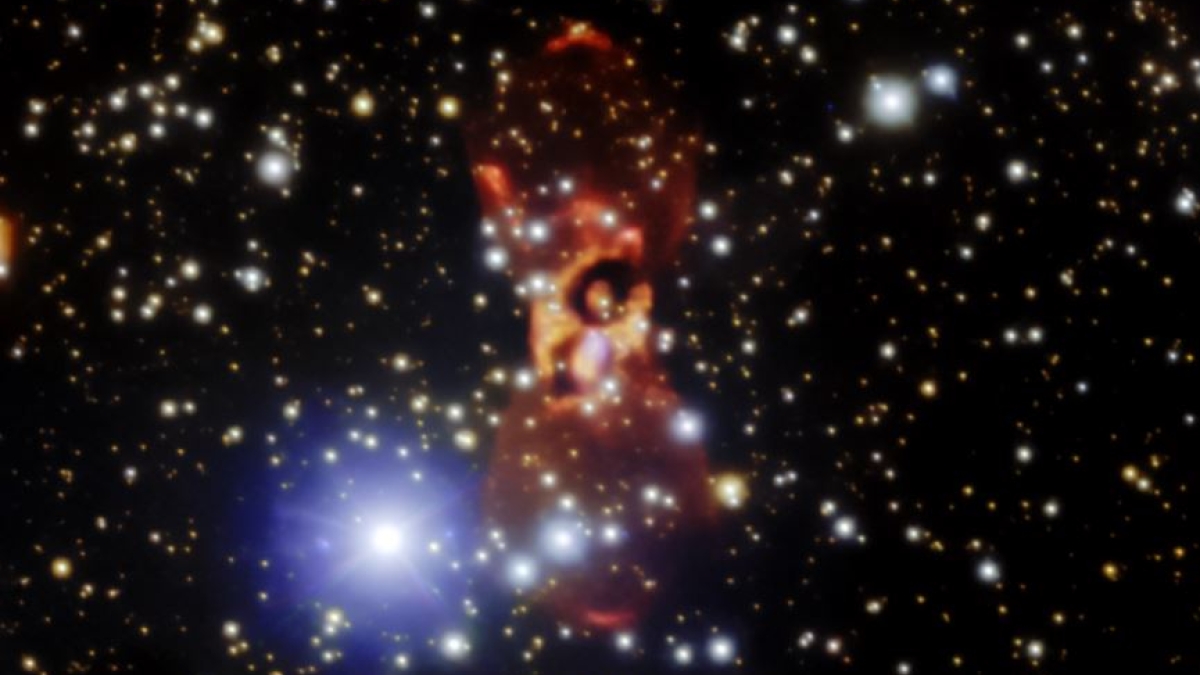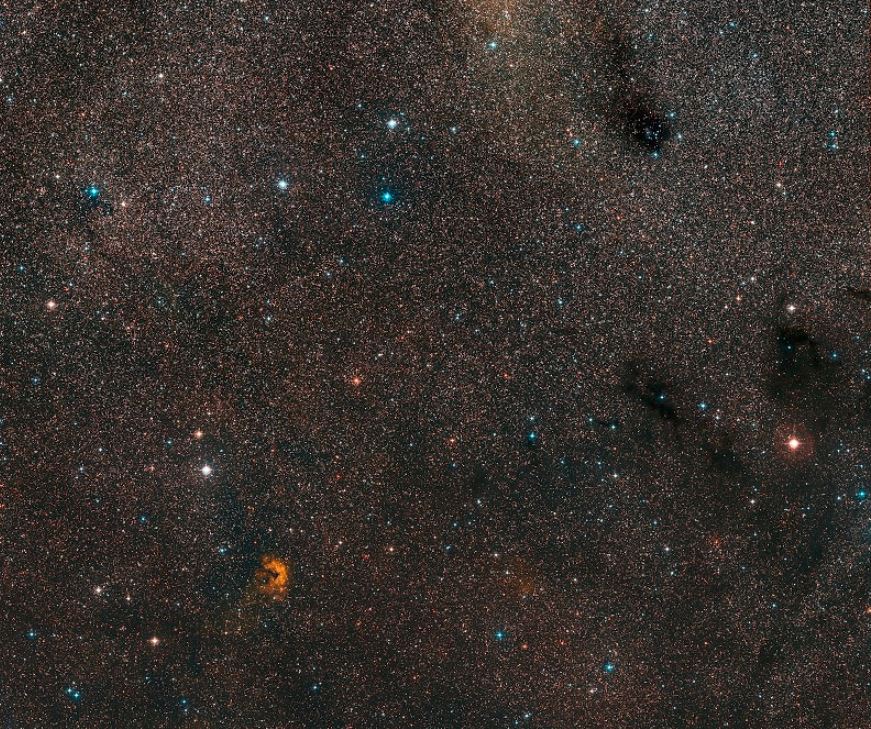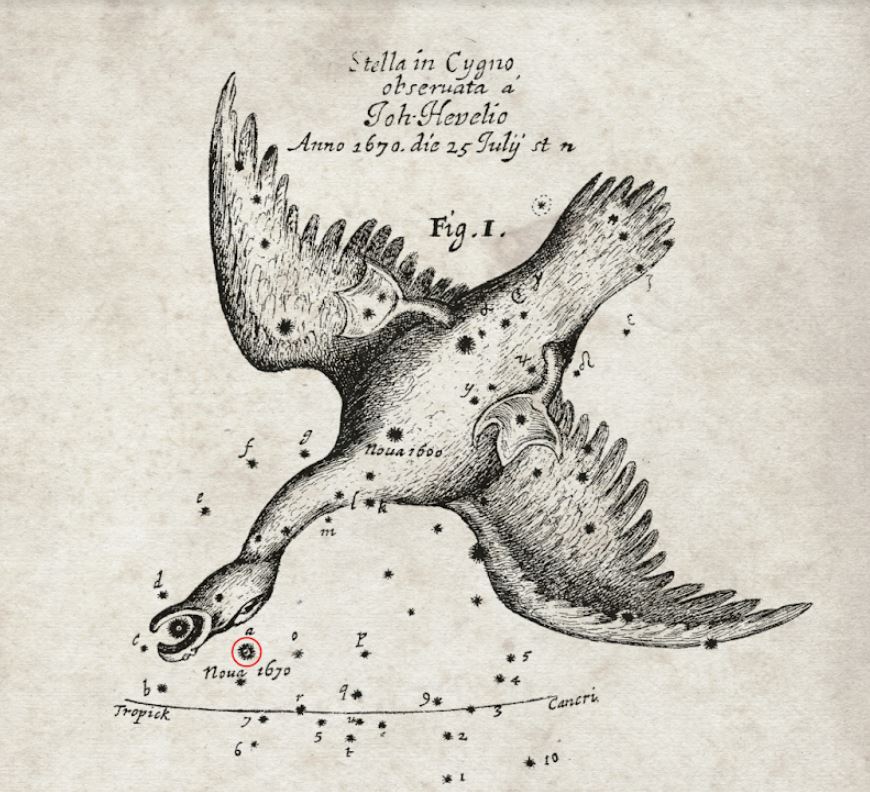Blast from the past: Observatory discovery helps unravel astronomical mystery

The CK Vulpeculae nebula. The astronomers measured the speeds and changes in positions of the two small reddish arcs about 1/4 of the way up from the bottom and 1/4 of the way down from the top to help determine that the nebula is expanding five times faster than previously thought. Credit: International Gemini Observatory/NOIRLab/NSF/AURA
An international team of astronomers using new observations from the Gemini Observatory have discovered that CK Vulpeculae, first seen as a bright new star in 1670, is approximately five times farther away than previously thought.
This makes the 1670 explosion of CK Vulpeculae much more energetic than previously estimated and puts it into a mysterious class of objects that are too bright to be novae, but too faint to be supernovae.
Almost exactly 350 years ago, the French monk Anthelme Voituret saw a bright new star flare into life in the constellation of Vulpecula. Over the following months, the star became almost as bright as Polaris, known as the North Star, and was monitored by some of the leading astronomers of the day before it faded from view after a year.
The new star eventually gained the name CK Vulpeculae and was long considered to be the first documented example of a nova — a fleeting astronomical event arising from an explosion in a close binary star system in which one member is a white dwarf, a remnant of a sun-like star.
However, a string of recent results has thrown the long-standing classification of CK Vulpeculae as a nova into doubt, including findings recently published in the Astrophysical Journal of the American Astronomical Society with co-author and astrophysicist Sumner Starrfield of Arizona State University.
“The new Gemini observations have shown that they are bipolar lobes and we can use their velocities and improved imaging of their expansion to obtain a new distance of nearly 10,000 light years. This is considerably larger than previously believed,” said Starrfield, who is a Regents Professor with ASU’s School of Earth and Space Exploration. “At this distance, it was much brighter than we thought and in fact was one of the brightest systems in the galaxy for a short time, exceeded only by that of a supernova.”

This wide-field view shows the sky around the location of the historical exploding star CK Vulpeculae. The remains of the nova are only very faintly visible at the center of this picture. Credit: ESO/Digitized Sky Survey 2.
In 2015, a team of astronomers suggested that CK Vulpeculae’s appearance in 1670 was the result of two normal stars undergoing a cataclysmic collision. Just over three years later, the same astronomers further proposed that one of the stars was in fact a bloated red giant star following their discovery of a radioactive isotope of aluminum in the immediate surroundings of the site of the 1670 explosion.

This chart of the position of a nova (marked in red) that appeared in the year 1670 was recorded by the famous astronomer Hevelius and was published by the Royal Society in England in their journal Philosophical Transactions. Credit: Royal Society
Complicating the picture even further, a separate team of astronomers proposed a different interpretation. In their paper, also published in 2018, they suggested that the sudden brightening in 1670 was the result of the merger between a brown dwarf — a failed star too small to shine via thermonuclear fusion that powers the sun — and a white dwarf.
Now, adding to the ongoing mystery surrounding CK Vulpeculae, new observations from the Gemini Observatory, a program of the National Science Foundation’s NOIRLab, have revealed that this enigmatic astronomical object is much further away and has ejected gas at much higher speeds than previously reported.
The team, led by Dipankar Banerjee of Physical Research Laboratory Ahmedabad, India, Tom Geballe of Gemini Observatory and Nye Evans of Keele University in the United Kingdom, initially planned to use the Gemini Near-Infrared Spectrograph (GNIRS) instrument on Gemini North to confirm the 2018 detection of radioactive aluminum at the heart of CK Vulpeculae. After realizing that detecting this in the infrared would be far more difficult than they originally thought, the astronomers improvised and obtained infrared observations across the full extent of CK Vulpeculae, including the two wisps of nebulosity at its outermost edges.
“The key to our discovery was the GNIRS measurements obtained at the outer edges of the nebula,” Geballe said. “The signature of red-shifted and blue-shifted iron atoms detected there shows that the nebula is expanding much more rapidly than previous observations had suggested.”
As lead author and astronomer at the Physical Research Laboratory in India, Banerjee explained, “We did not suspect that this is what we would find. It was exciting when we found some gas traveling at the unexpectedly high speed of about 7 million km/hour. This hinted at a different story about CK Vulpeculae than what had been theorized.”
By measuring both the speed of the nebula’s expansion and how much the outermost wisps had moved during the last 10 years, and accounting for the tilt of the nebula on the night sky, which had been estimated earlier by others, the team determined that CK Vulpeculae lies approximately 10,000 light- years distant from the sun — about five times as far away as previously thought.
That implies that the 1670 explosion was far brighter, releasing roughly 25 times as much energy than previously estimated. This much larger estimate of the amount of energy released means that whatever event caused the sudden appearance of CK Vulpeculae in 1670 was far more violent than a simple nova.
“This brightness seems to rule out the previously believed idea that it was a merger of a star and a brown dwarf. And there seems to be too much mass of gas and dust in the system to be the result of a merger,” Starrfield said. “Our bottom line is we do not know what caused the outburst as yet. We cannot see through the dust to the underlying object which is still hidden.”
This article was written by the National Science Foundation's NOIRLab communications team with contributions from Karin Valentine with ASU's School of Earth and Space Exploration.
More Science and technology

NASA launches space telescope to chart the sky and millions of galaxies
California’s Vandenberg Space Force Base was the site for Tuesday’s 8:10 p.m. launch of the NASA SPHEREx mission aboard a SpaceX…

ASU-led Southwest Sustainability Innovation Engine funds 8 promising tech startups
In the startup world, tech companies often fall victim to what’s known as the “valley of death” — the gap between technological…

New study explores the link between diet, blood sugar and cancer risk across species
Researchers have long known that diet exerts a profound influence on health, including the risk of developing cancer. A new study…

